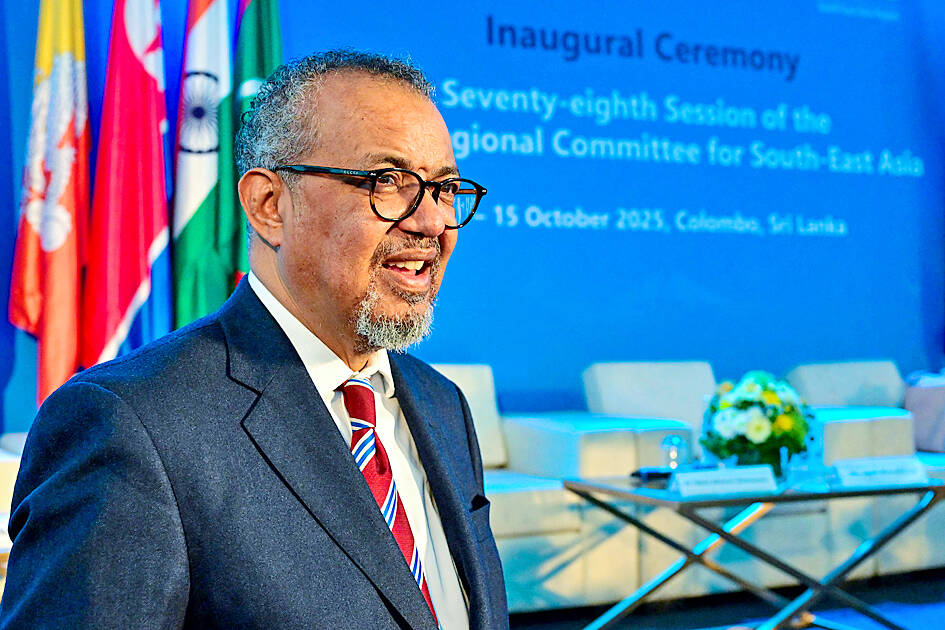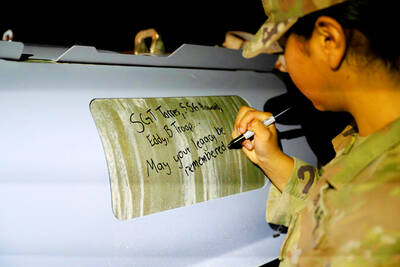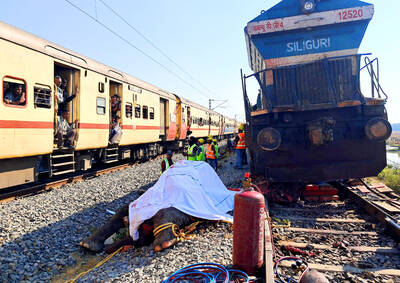The WHO yesterday sounded the alarm over soaring numbers of drug-resistant bacterial infections, compromising the effectiveness of life-saving treatments, and rendering minor injuries and common infections potentially deadly.
The UN health agency warned that one in six laboratory-confirmed bacterial infections worldwide in 2023 showed resistance to antibiotic treatments.
“These findings are deeply concerning,” Yvan J-F. Hutin, head of the WHO’s antimicrobial resistance department, told reporters. “As antibiotic resistance continues to rise, we’re running out of treatment options and we’re putting lives at risk.”

Photo: AFP
Bacteria have long developed resistance against medicines designed to fight them, rendering many drugs useless.
This has been accelerated by the massive use of antibiotics to treat humans, animals and food.
Antimicrobial-resistant (AMR) superbugs directly cause more than 1 million deaths and contribute to nearly 5 million deaths every year, the WHO said.
In a report on AMR surveillance, the WHO examined resistance prevalence estimates across 22 antibiotics used to treat infections of the urinary and gastrointestinal tracts, the bloodstream and those used to treat gonorrhea.
In the five years leading to up 2023, antibiotic resistance increased in more than 40 percent of the monitored antibiotics, with an average annual rise of between 5 and 15 percent, the report found.
For urinary tract infections, resistance to antibiotics was typically higher than 30 percent globally, it showed.
The report looked at eight common bacteria pathogens, including Escherichia coli and Klebsiella pneumoniae, which can lead to severe bloodstream infections that frequently result in sepsis, organ failure and death.
The WHO warned that more than 40 percent of E coli infections and 55 percent of K pneumoniae infections globally are now resistant to third-generation cephalosporins — the first-choice treatment for these infections.
“Antimicrobial resistance is outpacing advances in modern medicine, threatening the health of families,” WHO Director-General Tedros Adhanom Ghebreyesus said in a statement.
The WHO hailed improvements in surveillance, but warned that 48 percent of nations were still not reporting any AMR data.
“We are definitely flying blind in a number of countries and regions that have insufficient surveillance systems for antimicrobial resistance,” Hutin said.
Judging from the available data, most resistance was found in places with weaker health systems and less surveillance, the WHO said.
The highest resistance was found in the Southeast Asian and eastern Mediterranean regions, where one in three reported infections were resistant.
In Africa, one in five infections was resistant.
Silvia Bertagnolio, who heads the WHO unit for antimicrobial resistance surveillance, told reporters that it was unsurprising that resistance would be higher in places with weaker health systems, since they might lack the capacity to diagnose or treat pathogens effectively.
The WHO has warned that there are not enough new tests and treatments in the pipeline to tackle the spread of drug-resistant bacteria.
This is creating a significant “future threat,” Hutin said.
“The increasing antibiotic use, the increasing resistance and the reduction of the pipeline is a very dangerous combination,” he said.

The Burmese junta has said that detained former leader Aung San Suu Kyi is “in good health,” a day after her son said he has received little information about the 80-year-old’s condition and fears she could die without him knowing. In an interview in Tokyo earlier this week, Kim Aris said he had not heard from his mother in years and believes she is being held incommunicado in the capital, Naypyidaw. Aung San Suu Kyi, a Nobel Peace Prize laureate, was detained after a 2021 military coup that ousted her elected civilian government and sparked a civil war. She is serving a

REVENGE: Trump said he had the support of the Syrian government for the strikes, which took place in response to an Islamic State attack on US soldiers last week The US launched large-scale airstrikes on more than 70 targets across Syria, the Pentagon said on Friday, fulfilling US President Donald Trump’s vow to strike back after the killing of two US soldiers. “This is not the beginning of a war — it is a declaration of vengeance,” US Secretary of Defense Pete Hegseth wrote on social media. “Today, we hunted and we killed our enemies. Lots of them. And we will continue.” The US Central Command said that fighter jets, attack helicopters and artillery targeted ISIS infrastructure and weapon sites. “All terrorists who are evil enough to attack Americans are hereby warned

Seven wild Asiatic elephants were killed and a calf was injured when a high-speed passenger train collided with a herd crossing the tracks in India’s northeastern state of Assam early yesterday, local authorities said. The train driver spotted the herd of about 100 elephants and used the emergency brakes, but the train still hit some of the animals, Indian Railways spokesman Kapinjal Kishore Sharma told reporters. Five train coaches and the engine derailed following the impact, but there were no human casualties, Sharma said. Veterinarians carried out autopsies on the dead elephants, which were to be buried later in the day. The accident site

‘NO AMNESTY’: Tens of thousands of people joined the rally against a bill that would slash the former president’s prison term; President Lula has said he would veto the bill Tens of thousands of Brazilians on Sunday demonstrated against a bill that advanced in Congress this week that would reduce the time former president Jair Bolsonaro spends behind bars following his sentence of more than 27 years for attempting a coup. Protests took place in the capital, Brasilia, and in other major cities across the nation, including Sao Paulo, Florianopolis, Salvador and Recife. On Copacabana’s boardwalk in Rio de Janeiro, crowds composed of left-wing voters chanted “No amnesty” and “Out with Hugo Motta,” a reference to the speaker of the lower house, which approved the bill on Wednesday last week. It is